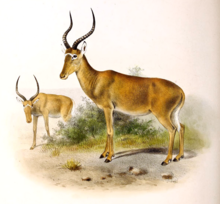| Hirola | |
|---|---|

| |
| Illustration by Philip Sclater in 1894 | |
| Scientific classification | |
| Domain: | Eukaryota |
| Kingdom: | Animalia |
| Phylum: | Chordata |
| Class: | Mammalia |
| Order: | Artiodactyla |
| Family: | Bovidae |
| Subfamily: | Alcelaphinae |
| Genus: | Beatragus |
| Species: | B. hunteri
|
| Binomial name | |
| Beatragus hunteri (Sclater, 1889)
| |

| |
| Range of the hirola | |
| Synonyms[2] | |
|
Cobus hunteri Sclater, 1889 | |
The hirola (Beatragus hunteri), also called the Hunter's hartebeest or Hunter's antelope, is a critically endangered antelope species found as of now, only in Kenya along the border of Somalia.[3] It was first described by the big game hunter and zoologist H.C.V. Hunter in 1888.[4][5] It is the only living member of the genus Beatragus, though other species are known from the fossil record.[2] The global hirola population is estimated at 300–500 animals and there are none in captivity.[6][7][8] According to a document produced by the International Union for Conservation of Nature "the loss of the hirola would be the first extinction of a mammalian genus on mainland Africa in modern human history".[9]
- ^ IUCN SSC Antelope Specialist Group (2017). "Beatragus hunteri". IUCN Red List of Threatened Species. 2017: e.T6234A50185297. doi:10.2305/IUCN.UK.2017-2.RLTS.T6234A50185297.en. Retrieved 11 November 2021.
- ^ a b Grubb, P. (2005). "Order Artiodactyla". In Wilson, D.E.; Reeder, D.M (eds.). Mammal Species of the World: A Taxonomic and Geographic Reference (3rd ed.). Johns Hopkins University Press. p. 675. ISBN 978-0-8018-8221-0. OCLC 62265494.
- ^ "Animals and Plants Unique to Kenya". lntreasures.com. Retrieved 2023-12-21.
- ^ Description of Hunter's antelope. Proceedings of the Zoological Society 1889, 372–377.
- ^ "ARKive". Archived from the original on 2013-10-29. Retrieved 2013-10-25.
- ^ Probert, J. (2011) The Tsavo hirola: current status and future management. MSc thesis. Imperial College London, UK
- ^ King, J., Craig, I., Andanje, S. and Musyoki, C. (2011) They Came, They Saw, They Counted, SWARA, 34: (2).
- ^ James Probert, Ben Evans, Sam Andanje, Richard Kock and Rajan Amin. Population and habitat assessment of the Critically Endangered hirola Beatragus hunteri in Tsavo East National Park, Kenya. Oryx, available on CJO2014. doi:10.1017/S0030605313000902.
- ^ "IUCN - A sanctuary for Hirola". Archived from the original on 2013-10-29.
